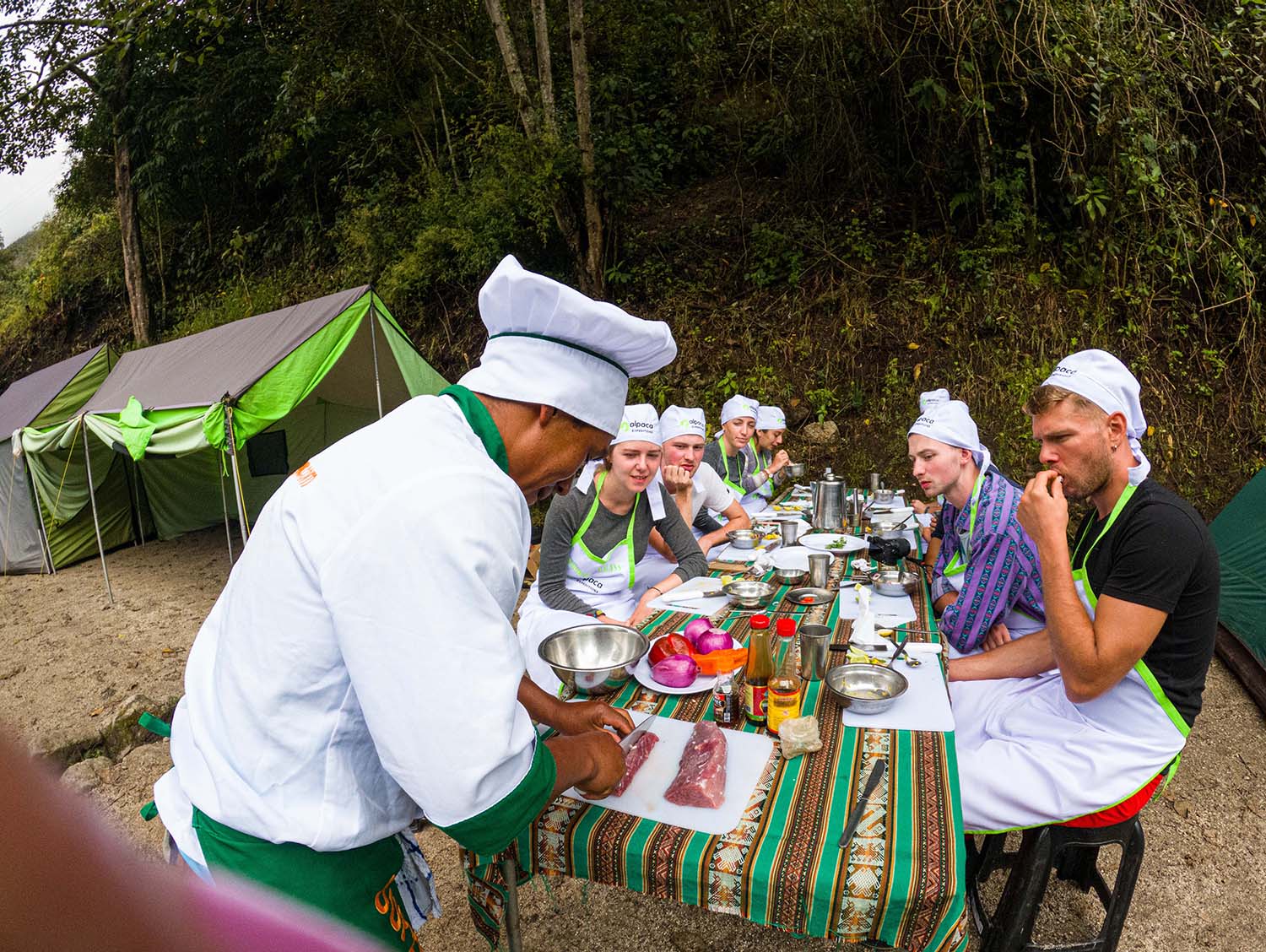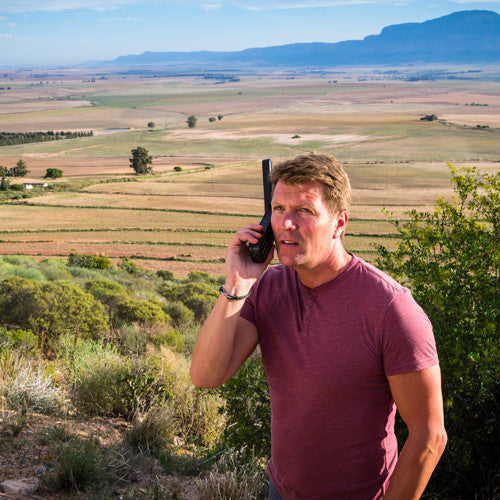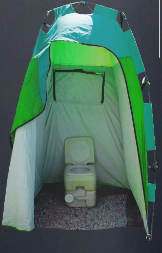Inca Trail Hike 4D/3N &
Rainbow Mountain + Red Valley 1 Day
Inca Trail Hike Overview
Tour Type: Hiking, camping, adventure, history, culture.
Total Distance: 50KM/31 Miles.
Good For: Those who enjoy hiking and have a moderate level of fitness.
Difficulty: Challenging.
Considerations: Permit required (We will obtain it after you book with us).
Season: From March 1st to January 31st.
Trail closed: February for maintenance.
Inca Trail Hike 4D/3N & Rainbow Mountain + Red Valley 1 Day
Trip Details
-
Highlights
The government has sanctioned a small portion of the thousands of miles of Inca Trail preserved for this hike. This popular classic route is 26 miles and takes 4-days. You can do this same route at a slower pace for a 5-day trek. For those wanting to make it more challenging, there is a 7-day trek that combines the Salkantay pass with the Inca Trail. There is also s short 2-day version, that has one day of hiking and one day at Machu Picchu. No matter which route you choose, you will need a PERMIT to do the trek.
-
Itinerary Overview
- Day 1: Km 82 – Llactapata- Ayapata (Trekking Distance: 8.7 miles/14 km (6-7 hours)
- Day 2: Dead Woman´s Pass – Runcuraccay Pass – Chaquiccocha (Trekking distance: 9.94 miles/16 km (7-8 hours)
- Day 3: Chaquiccocha – Wiñaywayna (Trekking Distance: 6.2 miles/10km (5 hours)
- Day 4: Machu Picchu (The most exciting and magical day (early wake up 3:30 AM)
- Day 5: Rainbow Mountain & Red Valley.
-
IMPORTANT NOTE
The Ministry of Culture in Peru is in charge of all regulations of the Inca Trail, including permits and campsites. To enter the Inca Trail, you must have a permit that matches your NAME, PASSPORT NUMBER, NATIONALITY, and AGE issued by the Ministry of Culture. Only licensed Inca Trail tour operators can secure these, and they are not transferable in date or name at any time. If you are unable to start your Inca Trail trek on your start date, you can not transfer to another person. If you need to change your start date, you will need to make sure permits still exist for the new date and purchase a new permit. These are all rules of the government of Peru that we need to follow.
If permits are sold out for your desired start date, there are lots of other roads that lead to Machu Picchu. We can help you find the perfect trek for you.
Highlights
Itinerary
-
Day 1: Cusco – Piskacucho Km 82 – Llactapata- Ayapata
Alpaca Expeditions will pick you up from where ever you are staying in Cusco, Urubamba, or Ollantaytambo. Pick-up from Cusco will be from 4 to 4:30 AM, from Urubamba from 5:30 to 6 AM, and if you stay in Ollantaytambo, you get to sleep in a bit with your pick-up from 6:30 to 7 AM. These times will be confirmed at your briefing, as they might fluctuate based on where you are staying. We will take you to the Porter House which is located in Ollantaytambo after a delicious breakfast prepared by your cook, your guide will introduce you to your team of porters.
We will then drive to Km 82, we’ll go through the first Inca Trail checkpoint to begin our trek. Please make sure you have your original passport with you to enter the Inca Trail. The first 2 hours of the trek are relatively easy as we make our way to our first Inca site. Patallacta is an ancient Inca checkpoint for the approach to Machu Picchu.
From Patallacta it’s another 2-hour hike to our lunch stop. After lunch, we will hike for another 2½ hours until we reach the first night’s campsite at Ayapata (3300 meters). On this last stretch, we pass through 2 small communities. If you want to buy any energy drink, snacks, or essential items you may have forgotten such as batteries you can do so here. We’ll arrive at our campsite by 5:00 PM. After settling in for a bit, you can relax and have a hot drink and snack with your team of porters, chefs, and guides. By 7:30 PM, your dinner will be ready, and after you can get some well-deserved rest.
Walking distance: 8.7 miles/14 km (6-7 hours)
Campsite altitude: 3300 meters (high) above sea level
Considered: Moderate day (getting used to the Inca Trail)
Weather: Warm and windy -
Day 2: Dead Woman´s Pass – Runcuraccay Pass – Chaquiccocha
Your porters will wake you up early with a hot cup of coca tea to get you ready for the day. We will have an early start since it will be our longest day. We’ll hike for roughly 4 hours to the highest pass of the trek, Dead Woman’s Pass (4215 meters/13829 feet). On reaching the pass, we’ll stop for a short break to enjoy the views before setting off again to descend to the next valley (Pacaymayu Valley – Hidden River). It’s another hour and a half down the side of the valley to our lunch spot, where you will have a chance to refill your water bottles. After lunch, we begin ascending again to the second pass of the trek. It’s 2 hours over the pass where we will stop at a small Inca site (Runcu Raccay) and see two huge waterfalls cascading down the opposite side of the valley. After the second pass, it’s another hour downhill hike to reach the magnificent Inca site, Sayacmarca (an otherwise inaccessible village).
We’ll stop here to rest and have a quick tour. Afterward, we will be able to watch the sunset over the Vilcabamba mountain range. It’s then just another 20 minutes until we stop for the night at our second campsite Chaquicocha (Dry Lake, 3600 meters). After dinner, if you’re not too exhausted, we can do some star gazing, and we’ll point out the fascinating Inca constellations. In the magnificent Southern Hemisphere sky, away from all the artificial lighting, this sky is something to behold!
Walking distance: 9.94 miles/16 km (7-8 hours)
Campsite altitude: 3600 meters (high) above sea level (chilly weather)
Considered: Top day (you will have survived the two highest passes)
Area: Andes and Cloud Forest
Weather: Cold and rainy -
Day 3: Chaquiccocha – Wiñaywayna
Completing Day 2 and beginning Day 3 certainly deserves a pat on the back! We will start early again, waking up at 6:30 am to begin what is commonly felt to be the most beautiful day of the whole Inca Trail. We hike for 2 hours along what we like to call “Inca flat” (gradual inclines) and begin to enter the jungle, known as the Cloud Forest. As we walk, we will have the opportunity to see Salkantay, the second highest snow-capped mountain in the Sacred Valley, and a fantastic panoramic view of the Vilcabamba mountain range. Towards the end of the Inca flats, we begin to make our way up to the last peak at Phuyupatamarka (3600 meters) from where we’ll have great views overlooking the Urubamba River. Down the valley, we get our first view of Machu Picchu Mountain, but the site itself is still hidden. From Phuyupatamarka it´s a 3-hour walk down a flight of steps to our last campsite, close to Wiñay Wayna (Forever Young). Wiñay Wayna is the most spectacular Inca site on the trail after Machu Picchu and the most popular campsite because of its proximity to Machu Picchu. During the descent, we visit 2 Inca ruins, Phuyupatamarka (Town in the Clouds) and Intipata (Terraces of the Sun). We arrive at our campsite around 1:00 PM to have lunch.
Then we will relax so that you are ready for your final day at Machu Picchu. At around 4:30 PM your guide will give you a short orientation, and you will visit the Inca ruins of Wiñay Wayna for an hour and a half there. Your guide will explain the significance of the site and combine all the information given during the trek. This way you will be fully prepared for your visit to Machu Picchu the following day. We like to spoil our guests as we enjoy our last feast with the porters and chefs. It’s an Inca Trail tradition to organize a ceremony in the evening to introduce the team to the tourists once again. This is to thank them for the great job done (if you wish to provide tips for them then you can do so at this time). It is advisable to go to bed at a reasonable time to get up in the early hours of the morning to arrive to Machu Picchu at the crack of dawn in the hopes that the weather will give us a beautiful sunrise over the ruins at Machu Picchu.
Walking distance: 6.2 miles/10km (5 hours)
Campsite altitude: 2.600 meters (high) above sea level (chilly weather)
Considered: Easy day – all downhill!
Area: High Cloud Forest
Weather: Warm and very humid -
Day 4: Sun Gate - Machu Picchu – The Lost City Of The Incas
oday marks the most anticipated day of your journey, the long-awaited visit to Machu Picchu, one of the New Seven Wonders of the World.
We’ll wake up early at 3:00 a.m., and breakfast will be served at 3:30 a.m. Shortly after, we’ll begin a short walk to the park ranger checkpoint, where we’ll wait for the gates to open at 5:30 a.m.
Why so early? Our porters must reach the railway at Km 107 to catch the only daily train passing at 5:30 a.m. Out of respect for their effort, all groups wake early so the porters can return safely to Ollantaytambo. Your duffel bags will be transported by porters to Aguas Calientes and left at the restaurant where you’ll later have lunch.The final section of the Inca Trail from Wiñay Wayna to the Sun Gate (Inti Punku) is narrow, and park rangers only allow hikers to enter after dawn for safety. This portion takes about one hour, with lush cloud forest vegetation and occasional sightings of orchids. Just before reaching the Sun Gate, you’ll climb the steep “Gringo Killer” steps , about 20 original Inca steps that mark the final challenge before your reward.
Arriving at Inti Punku, you’ll witness your first breathtaking panoramic view of Machu Picchu. During Incan times, this gate served both as the main entrance to the citadel and as a solar observatory during the solstice, when sunlight aligned perfectly through its opening to illuminate the Sun Temple window. We’ll spend about 15–30 minutes here (weather permitting) before continuing for another hour of gentle downhill trekking to reach the citadel.
By 7:30–8:00 a.m., we’ll arrive at the main viewpoint of Machu Picchu, the iconic photo spot. After soaking in the view, we’ll exit briefly to use the restrooms (S/2) and leave any large backpacks in storage (US$5).We’ll then re-enter to begin our 2-hour private guided tour along Circuit 3B, exploring temples, water fountains, and sacred plazas. Your guide will explain the fascinating history and mysteries behind the Incan architecture.
After your tour:
- Those with Huayna Picchu tickets will begin their hike independently (guided tours are not allowed).
- Others can continue exploring additional sectors such as the Temple of the Condor or take more photos around the terraces.
When finished, take the bus down to Aguas Calientes for lunch at a local restaurant (not included). Your guide will provide your train tickets at this time.
Return Journey:
You’ll board your train to Ollantaytambo between 2:30 p.m. and 3:45 p.m. (Expedition or Voyager class, depending on availability). The scenic ride lasts about 1 hour 45 minutes, offering spectacular views of the river and surrounding mountains.Upon arrival in Ollantaytambo, an Alpaca Expeditions driver will be waiting to transfer you by private bus back to Cusco (approx. 2 hours). You’ll arrive between 6:00 p.m. and 8:30 p.m., where your stored luggage will be returned, and you’ll be dropped off at your hotel.
Highlight: The most exciting and magical day – arrival at Machu Picchu!
Area: High Cloud Forest and Subtropical Zone
Weather: Hot and very humid (bring plenty of water)
Meals: Breakfast Only
Accommodation: On your own (Cusco city) -
Day 5: Cusco – Trailhead - Rainbow Mountain - Cusco (Small group)
We will pick you up between 4:00 and 4:30 am from your hotel, Airbnb, or hostel in Cusco. After a scenic 2½-hour drive, we’ll arrive at the Phulawasipata trailhead (4,200 m / 13,780 ft) around 7:00 am. Here, our chef will prepare a delicious breakfast including coffee, hot chocolate, teas, bread, fruit salad, eggs, and other warm options to help you start the day right.Since Cusco sits at 3,300 m / 10,826 ft, mornings at the trailhead can be even colder. Be sure to bring a warm jacket, hat, scarf, and gloves to stay comfortable.
After breakfast, we’ll begin our 2-hour hike uphill toward the Rainbow Mountain range. The pace can vary depending on fitness and acclimatization—some hikers reach the top in 1½ hours, while others take up to 2¾ hours. Along the way, your guide will share fascinating insights about the mountains, their geology, and the local culture. You’ll also have the chance to spot llamas and alpacas grazing in the area.The trail is wide and stable, suitable even for those with mild vertigo. During the dry season, conditions are ideal but can be dusty; in the rainy season, the path may be slippery, so good waterproof hiking boots and trekking poles are highly recommended.
Upon reaching the summit around 9:00–10:00 am, you’ll have about 1 hour to take in the stunning panoramic views of the surrounding valleys and the majestic Ausangate Mountain (6,384 m / 20,944 ft), the highest peak in Cusco. Your guide will explain the geological origins of the mountain’s vibrant colors and share stories about its significance in Inkan history.
After photos and exploration, we’ll descend via a different route that leads to a spectacular viewpoint overlooking the Red Valley, a hidden gem that many hikers find even more breathtaking than Rainbow Mountain itself. The descent takes about 2½ hours, mostly downhill, ending near our starting point.There, your chef will be waiting with a freshly prepared lunch, including cold drinks, appetizers, soup, and a hearty main course. Afterward, we’ll drive about 2½ hours back to Cusco, arriving at your hotel between 5:30 and 6:00 pm.
Highlights: Stunning views of Rainbow Mountain and the Red Valley
Area: Andes Mountains near Cusco
Weather: Cold, especially in the morning
Meals Included: Breakfast and Lunch
Accommodation: On your own (Cusco City)
Inclusions
-
Included
- Professional Guides
All of our guides studied English and tourism at Cusco National University. They all grew up in the Cusco region, and are committed to teaching others about their heritage. They are fun yet professional and will ensure you are safe and happy. - Permits
As soon as we receive your details and deposit, we will purchase your permits (pending availability, check our Inca Trail Availability). These permits are for a specific date and in your name. They can´t be changed once confirmed. Only your passport number is allowed to be updated. The permit includes an entrance to Machu Picchu. - Briefing
The night before your trek, you will come to our office for your briefing. You will receive your duffel bag that will stay with your porters while you hike. This bag should not exceed 7kg/14 lbs and does need to include your sleeping bag and air mattress. - Porters
We include a personal porter who is responsible for carrying your duffel bag. There is no additional fee for this. You will not have access to your duffel bag until your evening campsite. - Transportation
You will have transportation included in this trek. You will be picked up directly from your hotel around 4 a.m. (unless you are staying in Ollantaytambo) and brought to KM 82 to begin your trek. Also included will be the Expedition Train from Aguas Calientes. You may also upgrade to the Vistadome Train for $75 per person. Once you arrive at the train station, we will take you back to your hotel in Cusco. Additionally, your round trip bus ticket from Aguas Calientes to Machu Picchu will be included. - Equipment
Alpaca Expeditions has the best equipment. We use Eureka Timberline 4 person tents that are shared by only two people. You will also have a spacious dining tent to enjoy your meals in. - Food
The Alpaca Expeditions chefs cook delicious meals that many previous trekkers have loved. We honor all food restrictions, so be sure to add any that you have on your booking form and let your guide know at your briefing. Food is typically all served family-style. - You will enjoy breakfast, lunch, and dinner each day for the trek along with a happy hour of tea and snacks. A snack will be provided each morning for you to enjoy along the hike. Your last meal with your chef will be after breakfast on day four. Lunch the last day is not included.
- Water
Beginning from your first lunch until your last breakfast, Alpaca Expeditions will supply all the water needed. This water is boiled, filtered, and then cooled before distributing. You must bring personal water bottles and or a camelback. We recommend carrying about 3L worth. You will be able to refill your water at each meal. - First Aid
Every Alpaca Expeditions guide has received training in first aid from a physician. We conduct mandatory training sessions every February, which every single Alpaca tour guide must attend. Your tour guide will always have a first-aid kit for basic medical situations (traveler´s diarrhea, cuts, scrapes, etc.) and oxygen. We will get you off the trail as quickly and comfortably as possible if needed, and ensure you get directly to a clinic for treatment. - Extras
We believe it´s the attention to small details that separates us from other tour companies. Every trekker receives a small pillow to sleep with, a foam mattress for insulation, a day pack cover to protect their things while hiking, and a rain poncho. We will work hard to create your best vacation. - Satellite Phones
Our top priority will always be the safety of our clients and our team. While all our guides are prepared and trained to deal with most issues clients have on the mountain. Being a phone call away from any doctor, hospital, or friend helps everyone feel assured that they are safe. Radios, which all our guides have, are limited in how far they can reach, so Alpaca Expeditions has added Satellite Phones to every trek. Every guide will have a fully charged phone that can be used anywhere on the mountain to connect us anywhere in the world. And they can be used by our clients for non-emergencies as well. While they are not cheap to use, they are available just in case you need to check in on the puppy you left at home with grandma. - Taxes and Fees
All taxes and permit fees associated with this trek are included in the listed price.
- Professional Guides
-
Not Included
- Rentals
Each trekker will need a sleeping bag for camping. Inflatable air mattresses and walking sticks (with rubber tips) are optional but highly recommended for additional comfort and support.If you prefer not to bring your own, the following items are available for rent:Sleeping Bag: $25
Inflatable Air Mattress: $20
Walking Sticks (Pair): $20
For the Rainbow Mountain hike, walking poles can also be rented for an additional cost of USD 10 per person. - Huayna Picchu
Huayna Picchu is the mountain that stands next to Machu Picchu. It is a 45-minute hike to the top. Going back down is quite steep if you are scared of heights. You would do this after your tour of Machu Picchu. The cost is $75. Arrangements need to be made at least one month in advance due to popularity. Please understand that the weather is out of our control.
- Rentals
Price
-
Price
$940 per person
-
Student Discount
$35 off per person
Student discounts apply to anyone who has a valid UNIVERSITY STUDENT CARD at the time of the trek or who is 17-years-old or younger. For those using a University Student Card our under 17-years-old, we need to see a copy of their card or passport at the time of booking to receive the discount.
-
Additional Items
Below is a quick list of prices, but check our Additional Options section for more details.
-
Huayna Picchu
Huayna Picchu is the iconic peak that rises beside Machu Picchu, famous for its steep stone pathways and breathtaking views. The hike typically takes about 45 minutes to 1 hour to reach the summit, depending on your pace. Although this portion is done independently, your guide will accompany you to the checkpoint and point out the trail entrance before you begin.
This hike requires an additional entrance ticket, which we can secure for you in advance, as availability is very limited.
Huayna Picchu tickets are issued in timed entry groups to manage trail capacity. The sessions currently offered are:
• Group 1: Entry from 7:00–8:00 AM
• Group 2: Entry from 9:00–10:00 AMWe usually book the 9:00–10:00 AM entry so you can fully enjoy your guided tour of Machu Picchu first, then begin the hike without rushing. Once inside the checkpoint, you may take your time ascending and descending.
The additional ticket cost is $75 USD per person.
-
Vistadome Train
All our tours include the Expedition Train, which is typically booked between 2:30 pm – 3:20 p.m. from Aguas Calientes.
If you prefer an upgraded experience, the Vistadome Train offers larger panoramic windows, more spacious seating, and onboard entertainment. The departure time for the Vistadome depends on availability and is usually scheduled at 1:37 p.m., 2:55 p.m., or 4:43 p.m. This train generally travels to the Ollantaytambo station, where private transportation will be waiting to take you back to your hotel.
If you would like a train that travels to Poroy or directly to Cusco, this can also be arranged with advance notice, though it is subject to availability and may incur an additional cost.
The Vistadome upgrade from Aguas Calientes to Ollantaytambo is $75 per person
Travel Info
-
BRIEFINGS
The evening before your trek, you will attend a 6:00 p.m. briefing at our office with your guide and the rest of your group. During this meeting, your guide will review the final details of the adventure and answer any last questions you may have.
You will also receive your duffel bag, which will be carried by the porters throughout the trek. This bag can hold up to 7 kg / 14 lbs in total, including your sleeping bag and air mattress if you choose to bring or rent them from us. Packing in layers works best for changing weather conditions along the trail.
-
DUFFEL BAGS
You will receive your duffel bags at your briefing. Your porters will carry them and have them returned to you at each campsite. They measure 66 cm long X 36 cm wide/2ft long X 1ft wide.
Every duffel has a maximum weight of 7kg. Remember 4kg will be for your clothes and other personal items. The remaining 3kg will be for your sleeping bag and pad.
-
PICKUPS
Alpaca Expeditions is one of the only companies to pick you up directly from your hotel. As long as your hotel is in the center of Cusco city, we will coordinate this pickup based on a time that your guide will discuss at the briefing. Pick up times may vary 30 – 45 minutes based on traffic conditions and previous pickups.
Cusco is an old city with cobblestoned streets and very narrow passageways. Smaller hotels and Airbnbs are often located on streets that cars can´t pass through. They also are frequently on hillsides with long steep climbs, making it difficult to carry luggage. We highly recommend that you book accommodations with better access. We have a list of hotels that are all comfortable with easy access to pick up and drop off. HOTEL LIST HERE.
Some treks will allow for pickups in the Sacred Valley, which is outlined below.
The following chart refers to possible locations we can pick you up from when beginning the tour.
Trek Possible Starting Locations Inca Trails Cusco, Urubamba, Yunahuara & Ollantaytambo Salkantay Treks Only Cusco Lares Trek Only Cusco Huchuy Qosqo Trek Only Cusco Ausangate and Rainbow Treks Only Cusco Day Tours Cusco, Urubamba & Ollantaytambo -
RETURNING TO CUSCO
We take care of every detail for your journey back to Cusco, so you can simply enjoy the moment and reflect on your amazing adventure.
Once you finish your visit at Machu Picchu, a shuttle bus will take you down to Aguas Calientes. This ride takes about 25 minutes, and buses run all day on a first-come, first-served basis.
From Aguas Calientes, you will take the tourist train to Ollantaytambo (approximately 1 hour 45 minutes). Upon arrival, look for our team member dressed in green and holding the Alpaca Expeditions sign at the station exit.
• Train services to Poroy or Cusco are limited, available only upon request, and require an additional fee. They are not always operated by the train companies.
From Ollantaytambo, you will travel in our private transportation for about 2 hours to Cusco. The route ends at Calle Arcopata, where your stored luggage will be waiting. Because large buses are not permitted to enter the historic center, a smaller vehicle will then take you directly to your hotel for a smooth and comfortable end to your trek.
-
MACHU PICCHU ENTRANCE & CIRCUITS
Machu Picchu now operates with specific timed entrances and assigned circuits.
The site is divided into three main circuits:
• Circuit 1 (Upper viewpoints: 1A, 1B, 1C, 1D)
• Circuit 2 (Central areas of the citadel: 2A, 2B)
• Circuit 3 (Lower sections: 3A, 3B, 3C, 3D)For Inca Trail hikers, the standard visit includes:
- Circuit 3B at 8:00 or 9:00 AM (subject to government availability)
- A short guided visit through part of Circuit 1B when you arrive through the Sun Gate on the final day of the trail
After you complete your assigned circuit, park rangers will guide you toward the exit, as re-entry is not permitted.
If you would like to spend more time exploring additional areas of Machu Picchu, you can request:
An additional entrance ticket for a different circuit
Extra tickets are:
• Subject to availability
• At an additional cost, which varies depending on the circuit you chooseWe are very happy to help secure this upgrade for you upon request.
-
HUAYNAPICCHU/MACHU PICCHU MOUNTAIN
Viewing Machu Picchu from above is a truly spectacular experience, which is why hiking one of the surrounding mountains is a popular optional add-on.
Huayna Picchu (circuit 3A)
This is the famous peak seen behind the citadel in classic photos. The trail is steep but rewarding, taking about 45 minutes up and 45 minutes down.
Huayna Picchu entrance tickets are sold in specific time slots, which determine when you must begin the hike:
• Entry times are at 7:00 AM and 9:00 AM
We typically reserve a later morning session, giving you time to enjoy the full guided tour of Machu Picchu first. The hike is done independently, but your guide will bring you to the trail entrance.
Machu Picchu Mountain (circuit 1A)
This mountain offers broader panoramic views and a longer climb, roughly 1.5 hours up and 1.5 hours back down.
Entry times are:
• 6:00 AM or 8:00 AM
Due to these early start windows, this hike cannot be combined with the full guided tour included in the 4-Day or 7-Day Inca Trail itineraries on the same day. You would need a second entrance ticket and an additional visit on the following day.
-
HEALTH CONCERNS
You must be honest with your guide about any health conditions or concerns you might have. While our guides are not medical professionals, they do have first aid training. We also work with a clinic in Cusco that can help assist our team.
You are responsible for assessing whether a Tour is suitable for you. You should consult your physician to confirm your fitness for travel and participation in any planned activities. You should seek your physician’s advice on vaccinations and medical precautions. Alpaca Expeditions will not provide medical advice. It is your responsibility to assess the risks and requirements of each aspect of the Tour based on your unique circumstances, limitations, fitness level, and medical requirements.
If you develop extreme altitude sickness or any other illness that prevents you from hiking, and you still wish to visit Machu Picchu by train, we will work with you to coordinate this trip. Since this will be a new trip, it may require additional fees. We will use as much of the original itinerary to keep costs low.
If you experience issues while hiking and can not continue, a porter will accompany you to the closest road and wait while a car comes to pick you up and bring you to the nearest health clinic.
-
GROUP TOURS
Group tours are made up of all different types of people, with various hiking skills and ages. By agreeing to a group tour, you agree that some people might be slower or faster than you are. Everyone can go at their own pace for the trek, and the guide will work with the group to spend time with everyone. Groups might request some modifications to the tour, and the guide will work with everyone to make the best decision for the group.
-
STRIKES
Unfortunately, strikes are frequent in Peru and can disrupt our tours. Roads are often blocked, and trains stopped. We will make sure your trek continues as planned, even if that means leaving the night before your start date. Under these circumstances, tours might need to be canceled. But our operations department will coordinate with you in this situation. Your safety is always our top concern and will dictate how we decide.
-
LOST ITEMS
You are responsible for your items throughout the Tour. Please be diligent about where you leave your things and remember to remove all items from our vans, your tents, restaurant, etc. Do not leave anything unintended during your hike. Other trekkers or teams might pick it up not knowing whos it is.
-
TIPS
Tipping is part of the tradition of any trek to Machu Picchu. While we pay good wages to our entire team, anything extra is always appreciated. Please know that this is not obligatory and that you should never feel pressured into this.
Typically the participants in a group pool their tipping money together for the porters and chef. The amount recommended is different per trek and listed below. For the guide, this is more personal and needs to be decided based on your relationship with them and done separately from the group. Porters and Chefs prefer soles if possible. Guides are happy with U.S. dollars, Peruvian Soles, or even your credit card 😉
Trek Per Porter Chef Inca Trails (4, 5 and 7 Days) 60 – 80 soles 150 soles 2D/1N Inca Trail with Camping 50 soles 100 soles Salkantay Treks 100-120 soles 200 soles Lares Trek 100-120 soles 200 soles Huchuy Qosqo Trek 50 soles 100 soles Ausangate 100-120 soles 200 soles * These numbers refer to what each member of the Green Machine should receive after the group pools their money. This is just a reference guide.
-
TRAVEL INSURANCE
To protect your travel investment, we highly recommend the purchase of travel insurance. Getting travel insurance before you leave home is strongly encouraged and very easy. We work with a great agency in the United States, that has helped to make it easy and affordable. What an excellent way to protect yourself while you are visiting Peru.
If interested in booking through our trusted partner, Ahart, Frinzi & Smith, CLICK HERE.
-
WEATHER
Of course, the weather is unpredictable. Typically the dry season in Cusco is from April through October, but this does not stop rain from falling in June or the sun from coming out in December so just be prepared. No matter what month you are doing the trek, make sure that you have rain gear that includes a waterproof jacket, pants, poncho, and waterproof gloves. Many people forget about gloves, but being cold and wet makes hiking very unpleasant.
Also, prepare for four seasons. Several of the treks through the Andes involve various microclimates and you will need to be prepared. Layers are always key since they are easy to adjust to different temperature changes. Be prepared with a warm packable down jacket since the evening will be cold.
It’s also important to note that the weather can change a listed itinerary. There are times that routes become impassable, and our guides will be forced for your safety to rework your tour.
-
ALTITUDE
As soon as people book their trip to Peru, specifically Cusco, they start wondering about altitude sickness. The air at high altitudes contains less oxygen than at sea level and forces your body to work harder to get the oxygen it needs. Over several days at high altitude, your body adjusts to the lower amount of oxygen in the air. For this reason, we always recommend spending at least two days in Cusco before beginning any trek in the Andes. Cusco is a marvelous city with lots to do, so if you have more time to acclimate you won´t be bored.
With altitude sickness, you may first feel like you have the flu or a hangover. You may have a headache, tiredness, loss of appetite, nausea or vomiting, dizziness, trouble sleeping, trouble breathing during exercise. If any of these effects become severe, please contact our office, and we will help you get to a doctor.
Most of the time, these symptoms will be mild. We always recommend easing into activity slowly, allowing your body to adjust. Drink plenty of fluids such as water or coca tea. Coca tea has been used since ancient times to help prevent altitude sickness. Leaves from the Coca Plant contain alkaloids that help bring oxygen into your blood, helping your body avoid the effects of altitude sickness. Avoid drinking a lot of alcohol and coffee. They will cause you to urinate more often and become dehydrated. Avoid smoking. Smoking makes it more difficult for your body to get oxygen. Avoid sleeping pills. They may cause shallow breathing at night, making it more difficult for your body to absorb oxygen while you sleep.
Remember the trek to Machu Picchu is not a race. Even those in the best shape will suffer from altitude sickness if they race to the top of the mountain too quickly. Go slow, and it will give your body time to adjust to the elevation.
Your healthcare provider may prescribe medications, such as acetazolamide and dexamethasone, to help prevent altitude sickness. Start the medicine two days before you get to a high altitude. Continue to take it while you are at high altitude.
You must remember that this is your holiday and you do not want to stress out about the possibility of getting sick from the mountains. Do everything slowly and drink lots of water, and enjoy the coca tea. If anything does happen and you, unfortunately, get sick, let your guide know right away. Alpaca Expedition guides are trained to help you get through it.
-
GETTING TO CUSCO
Cusco’s airport (Alejandro Velasco Astete International Airport) currently operates domestic flights only. All international travelers must first arrive in Lima, where you’ll go through immigration and customs. Even if you have a connecting flight to Cusco on the same airline, you’ll need to collect your checked bags in Lima and recheck them for your domestic flight.
The fastest and most convenient way to reach Cusco is by plane. Major airlines such as LATAM, SKY Airlines, and JetSMART offer multiple daily flights between Lima and Cusco (approximately 1 hour and 15 minutes). Because of Cusco’s high altitude and mountain weather, flight delays or cancellations can occur, so it’s best to plan some buffer time in your itinerary.
If you prefer to travel overland, comfortable long-distance buses are available. The journey from Lima takes about 20–22 hours, while routes from nearby cities such as Arequipa or Puno take between 6–10 hours. Peruvian bus companies such as Cruz del Sur and Oltursa are known for their safety and comfort, with reclining seats and onboard service.
Packing List
-
ESSENTIALS
- Passport
- Valid, STUDENT CARD (if you booked as a student)
- Good daypack (the smaller, the better)
- Water storage: Water reservoir like Camelbaks are encouraged – but enough for at least 2-3 liters.
- Comfortable hiking boots (lightweight with good soles)
-
FOR YOUR DUFFEL
Porters will carry up to 7 kg of your personal items. This must include your sleeping bag and air matt (if you bring/rent one). From us these two items weigh 3.5 kg.
- 2-3 wicking t-shirts
- 2-3 hiking pants
- 4 sets of undergarments.
- 4 sets of hiking socks
- 1 Fleece
- 1 Warm, down jacket: gets very cold at night
- 1 Rain jacket and pants
- 1 sun hat
- 1 wool hat
- Headlamp: essential
- Waterproof gloves (even if they are ski gloves, take them)
- Comfortable shoes for camp
- Walking boots
- Waterproof jacket/rain poncho
- Quickdry towel. We provide small ones, you might enjoy something a little larger.
- Small bottle of soap: we provide warm water each day to clean – might make you feel fresh if you had a little soap.
- Battery Charger: There is no place to plug in while trekking!
- Large plastic bags: to help organize and keep clean from dirty.
- Sleeping bag: Recommend down bags for -10C at least
-
TOILETRIES
- Sunscreen
- Face moisturizer
- Bug spray
- Handsanitizer
- Wet wipes
- Toothbrush and paste
- Toiletpaper
- Personal medication
- First aid kit: band aids, moleskin, etc.
-
INSIDE YOUR DAYPACKS
Daypacks can be any size for hiking, but we always say the smaller, the better. Inside Machu Picchu, bags larger than 25L will not be allowed in. If it is larger, you will need to store it outside citadel gates. But don´t worry, they have a secure storage facility.
- Water: we supply clean water at each meal. You are responsible for your first morning of water only as we won’t have time to filter water until your first lunch.
- Sunhat
- Rain gear
- Fleece
- Camera
- Music (IPhone)
- Handsanitizer
- Toilet paper and small plastic bag for waste
- Extra Money for Souvenirs, Drinks & Tips
- Earplugs
Inca Trail Hike 4D/3N & Rainbow Mountain + Red Valley 1 Day
Please fill in our BOOKING FORM carefully with your correct personal details.
The Alpaca Difference
Alpaca Expeditions is a 100% peruvian, indigenous owned company. Started by Raul Ccolque, a former porter and tour guide, Alpaca Expeditions separates ourselves by our dedication to both our customer and our team. We work very hard to make sure that all our clients needs are taken care of throughout the tour with us. At the same time, we never forget about our brothers and sisters working tirelessly for us to make all of this possible. Responsible and sustainable tourism that gives as much to our community as to our clients.
Meet the AE Trekking Team!
Everyone on the Alpaca Team is from Cusco region, living the traditions and history they share with you while on one of our tours. Our guides are all graduates of university studying tourism, history and english. Our chefs are trained every February by a professional cooking team learning new meals, adding varieties of entrees for all types of eating. And all our porters are from HUARQUI, HUACAHUASI, PATACANCHA, QUISWARANI, CANCHACANCHA, QUEYUPAY, UMACHURCO and CCACCACCOLLO villages, very often working this job on top of maining their farms back at home. Most of our team has been with us for years, as we have the most loyal, hard working, happy employees in Cusco. We know how lucky we are to have the best team trekking and you will immediately fall in love with all the men and women who call Alpaca Expeditions their home.
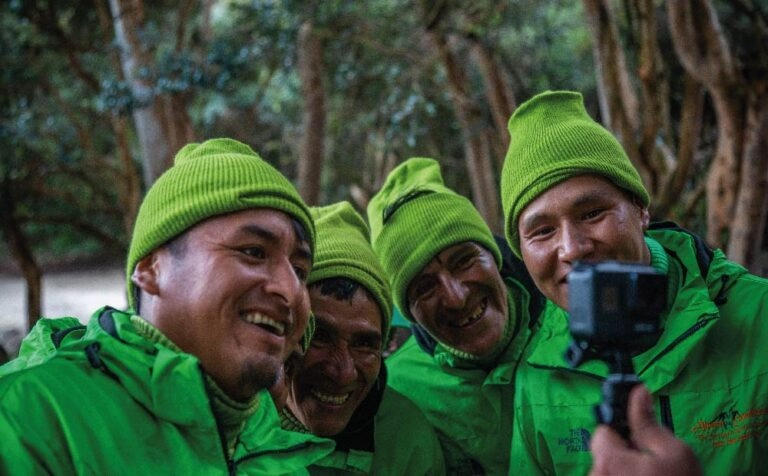
AE súper porters
Our Porters represent the Peruvian people, both men, and women who are at the heart of our...
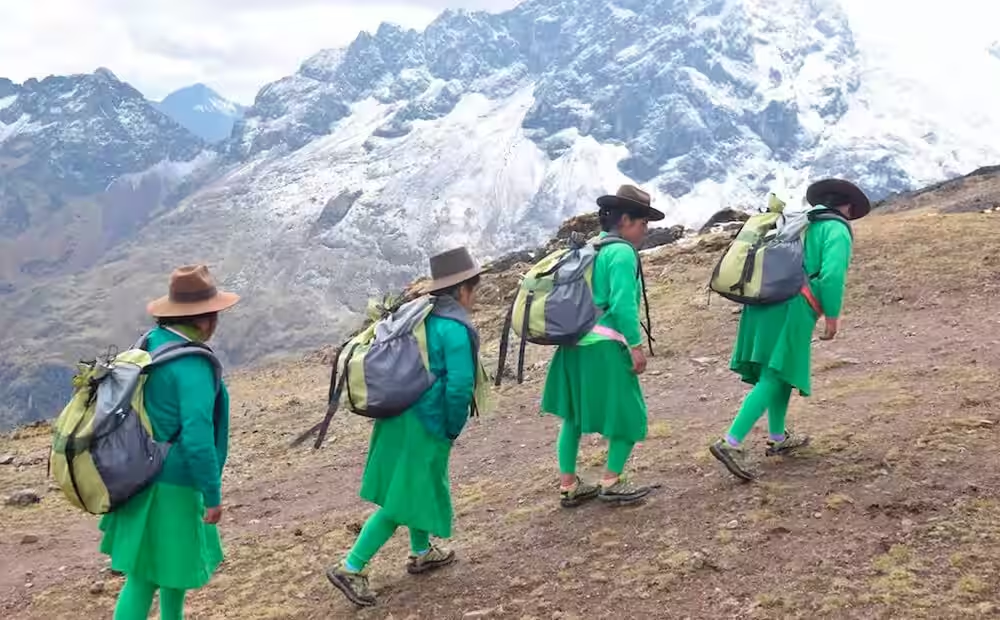
Equality Matters
Alpaca Expeditions aims to promote gender equality and empower women, hiring first Peru Wo...
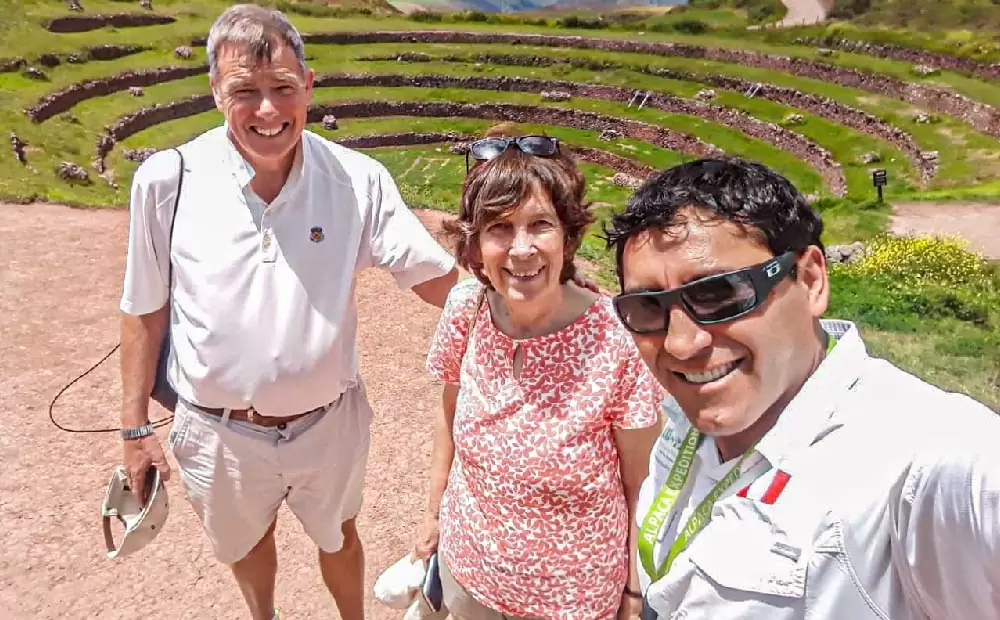
Our Guides
Travelling and trekking along the mountains is one of the best activities in the World. Co...

Our Chefs
Trekking along the mountain on your way to conquer Machu Picchu is a once in a lifetime ex...
What do we do for our porters?
Alpaca Expeditions would not be where we are today without these hardworking men and women. We could not imagine a harder job and our team does it smiling. We do our best to thank them for their hard work and loyalty by doing as much as we can to make their lives and their families lives better. All our porters receive all their equipment for free from warm winter hats to proper hiking boots. They sleep in proper tents and are given warm sleeping bags for night. They enjoy the same food we serve our clients and all leftovers are donated to their families. We visit their villages with doctors and dentists, donate school supplies and sports equipment. And our favorite time of the year is when we bring a group of porters and their families to Machu Picchu to visit the ruins for the first time.

AE súper porters
Our Porters represent the Peruvian people, both men, and women who are at the heart of our company. It is not possible to ...

Equality Matters
Alpaca Expeditions aims to promote gender equality and empower women, hiring first Peru Women as Porters opening the door ...

Free Medical Assistance to Porters
In 2019, we hired our first Alpaca Expeditions Medical Doctor to help tend to our guides, drivers, chefs…
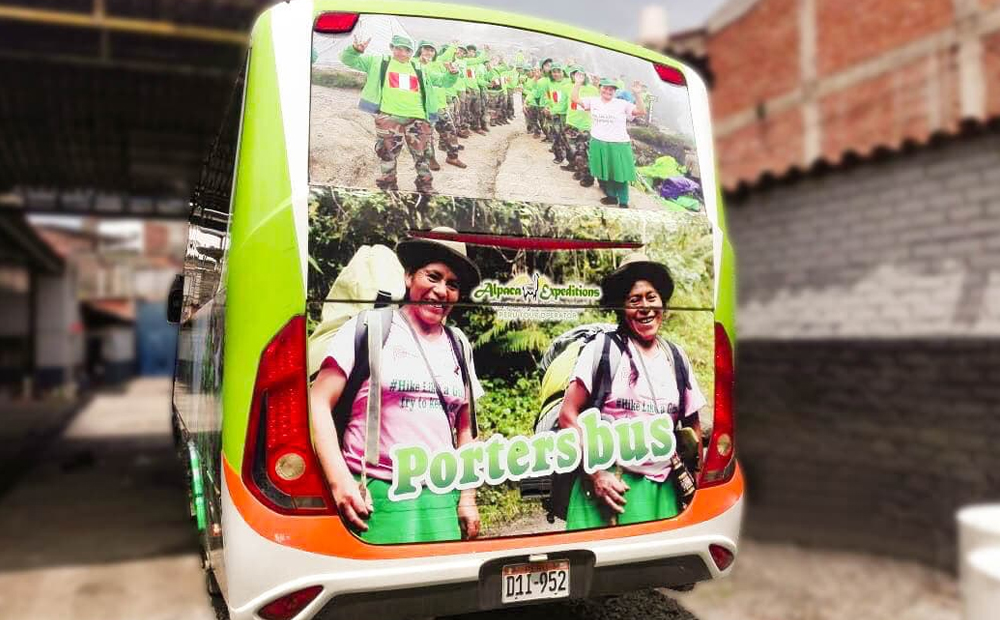
Our Porter’s bus
We treat our porters with the same dignity and respect as we do our clients. Just as our clients enjoy our…
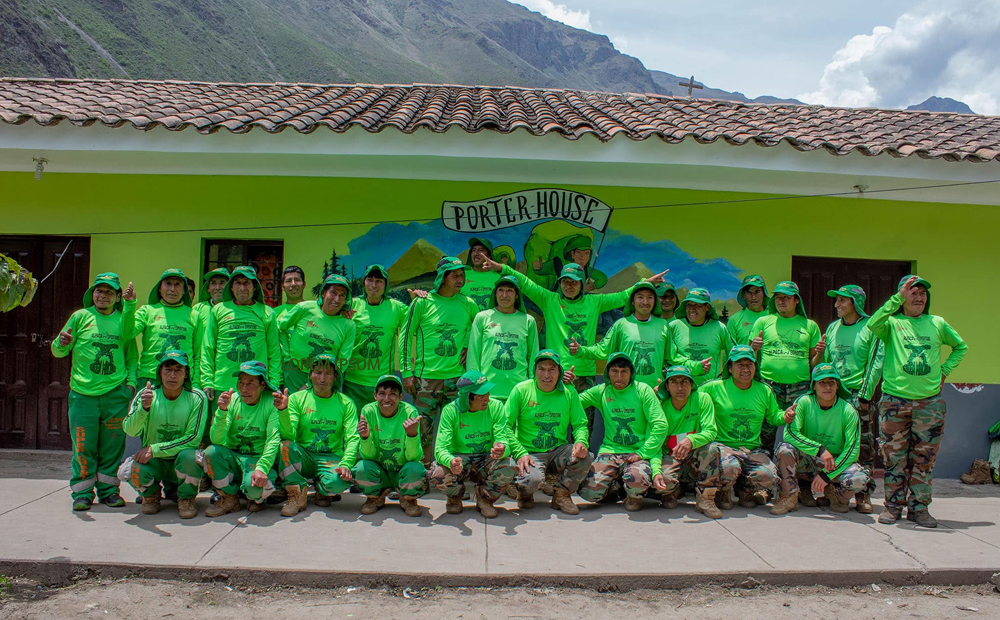
Our Porter’s House
As we mentioned above, our Porters like many Peruvian people come from distant villages to work our treks…
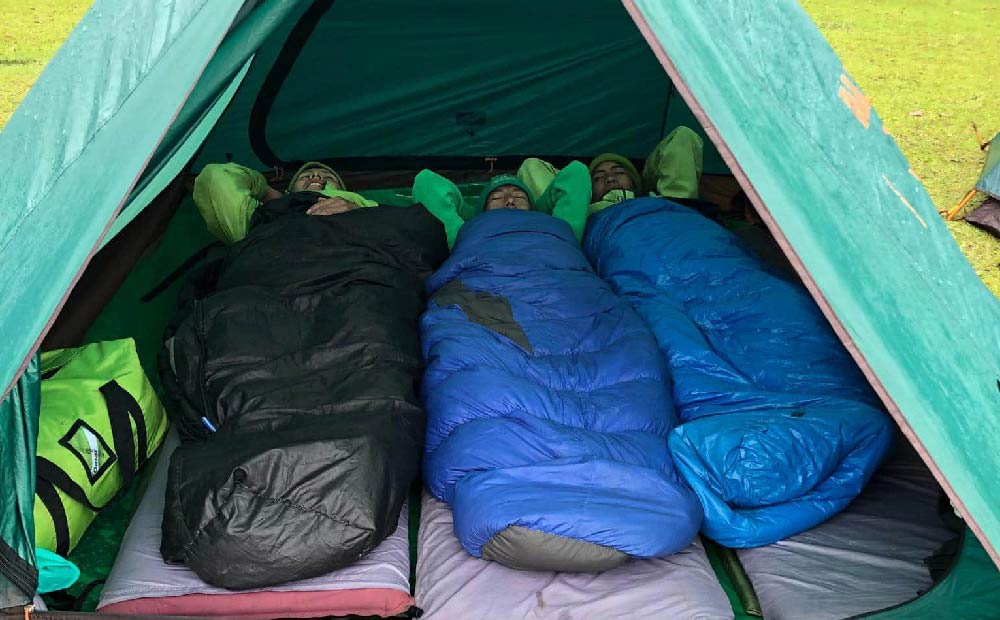
Tents and Sleeping bags
Again, this is something unique that Alpaca Expeditions provides, and sad others are not doing. We supply…
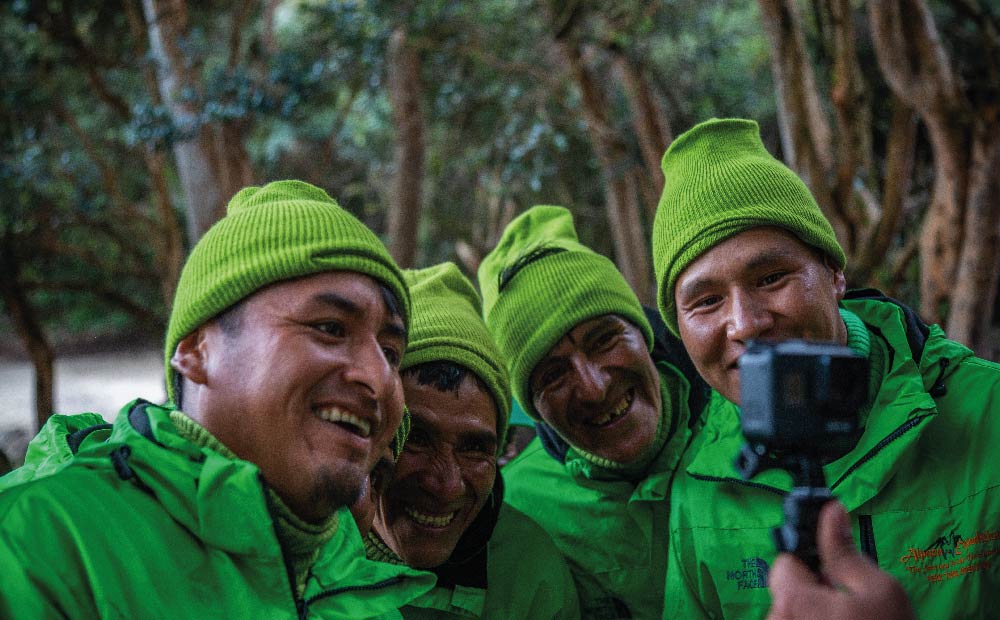
Proper Equipment for our Porters
Every porter of ours receives proper equipment. That includes moisture-wicking long/short sleeve shirts…
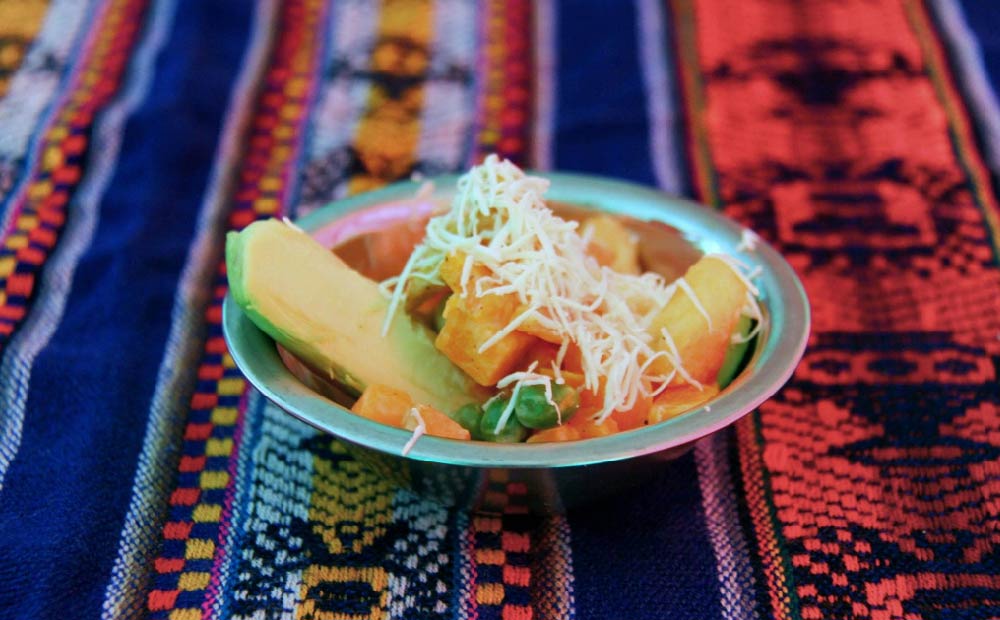
Nutritious Meals for our Porters
A general comment from trekkers on an Alpaca Expeditions tour is that we serve too much food. Well…
Videos of our Porters
Extra information
Alpaca Expeditions is always ready to make your trip safe and as easy as possible for you. Because these trips are a bit more complicated than your typical tour, we have put together some notes on logistics, storage, and even recommendations on where to stay in Cusco. And of course our team is ready to answer any other question, as we promise to be your partner from the moment you first contact us to our last goodbye in Cusco.
Alpaca Expeditions Recognitions
ISO (International Organization for Standardization)
In the pursuit to stand out from the rest, Alpaca Expeditions has obtained four ISOs plus our carbon footprint certificate to date. These achievements result from our efforts to implement the internationally-recognized integrated management system. They also represent our commitment to all of our clients and staff of operating sustainability and responsibility in every way possible.
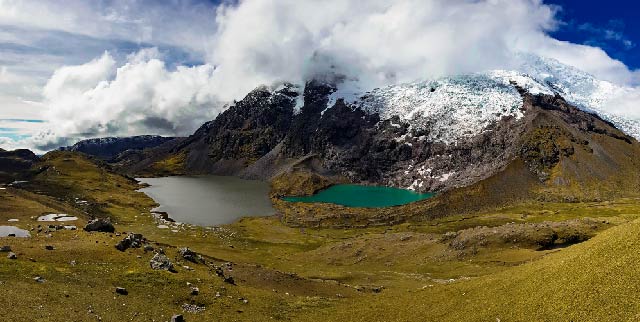


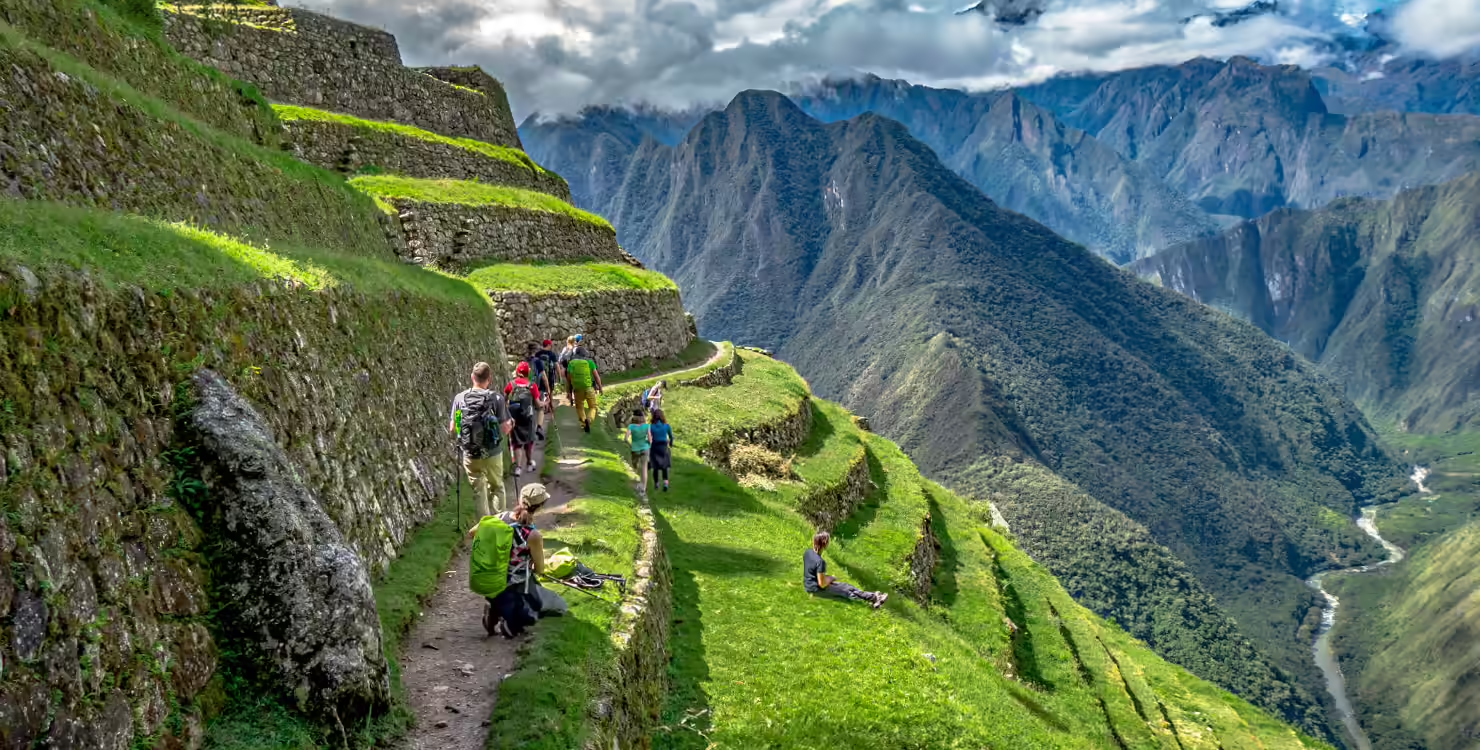
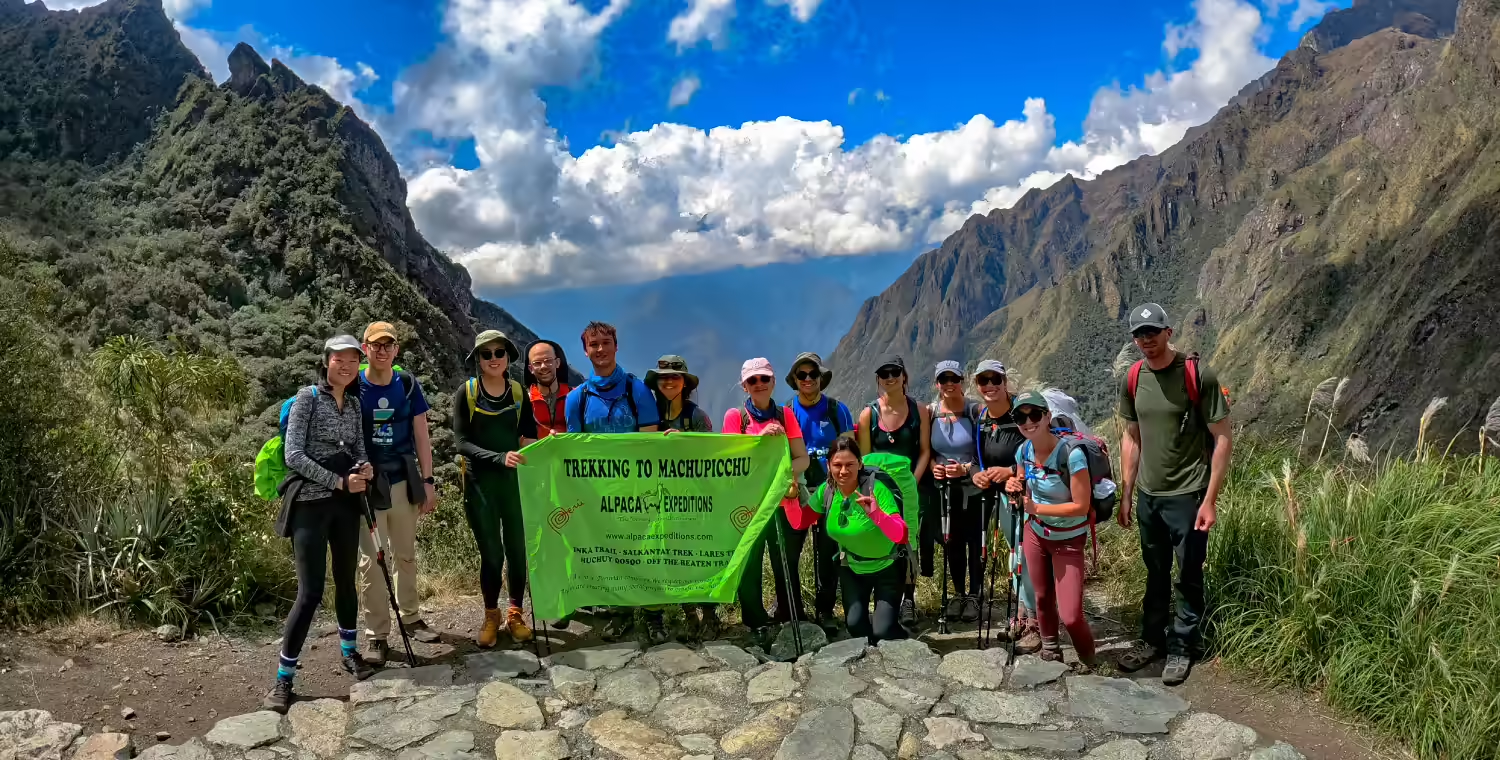


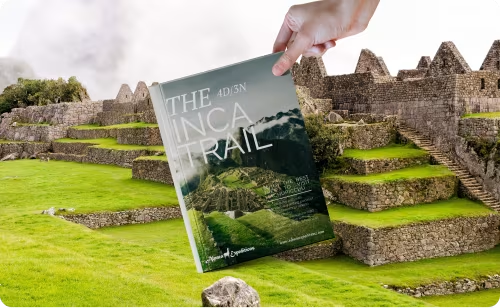

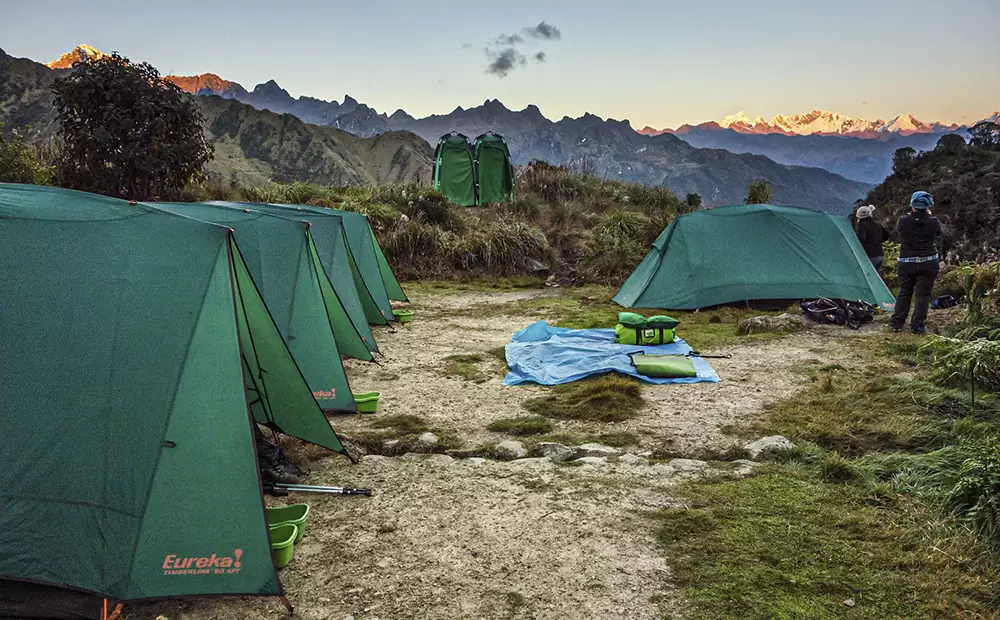
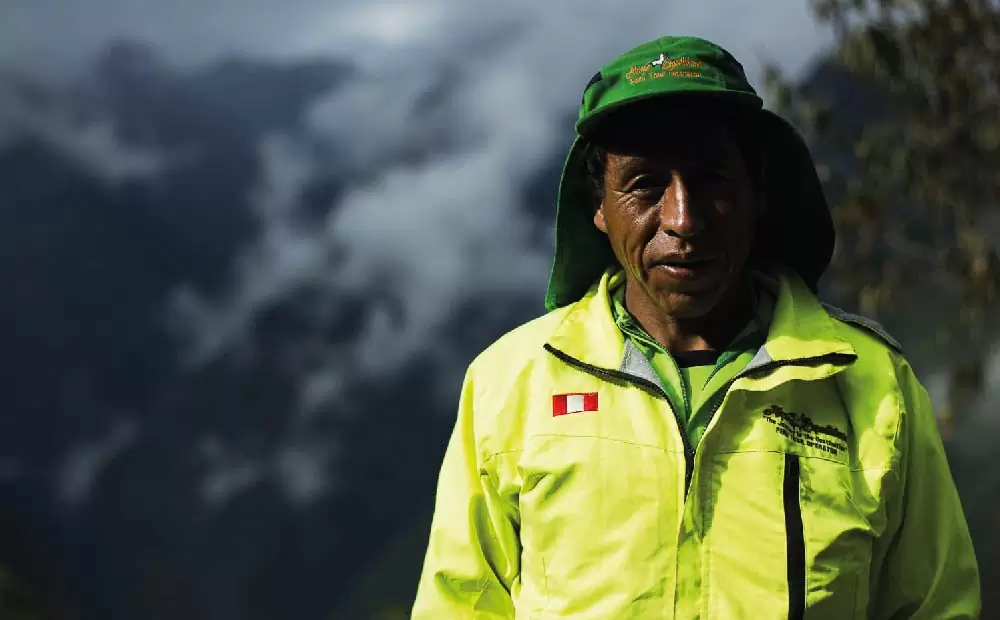
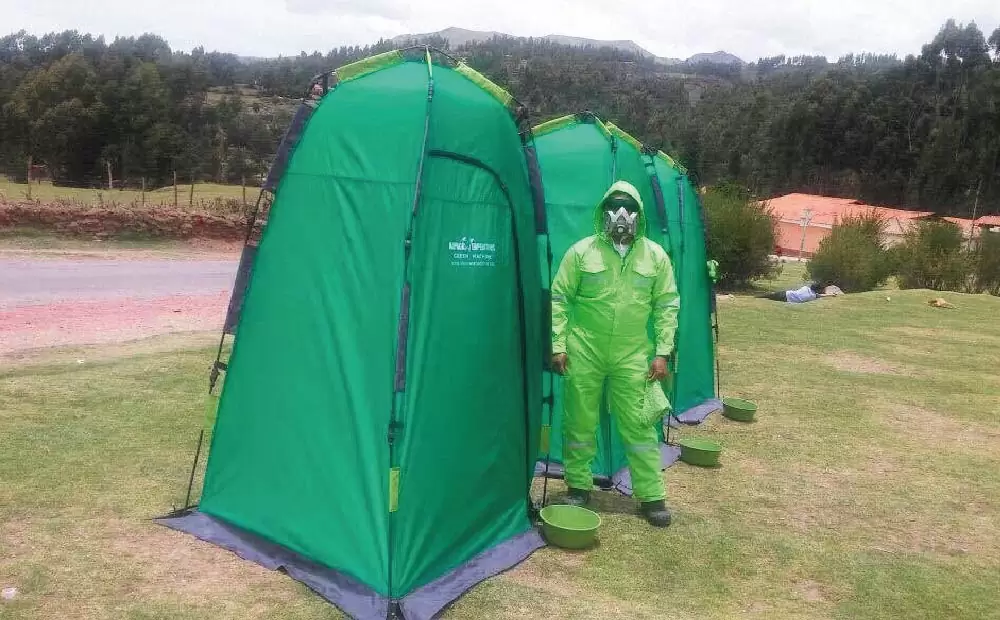
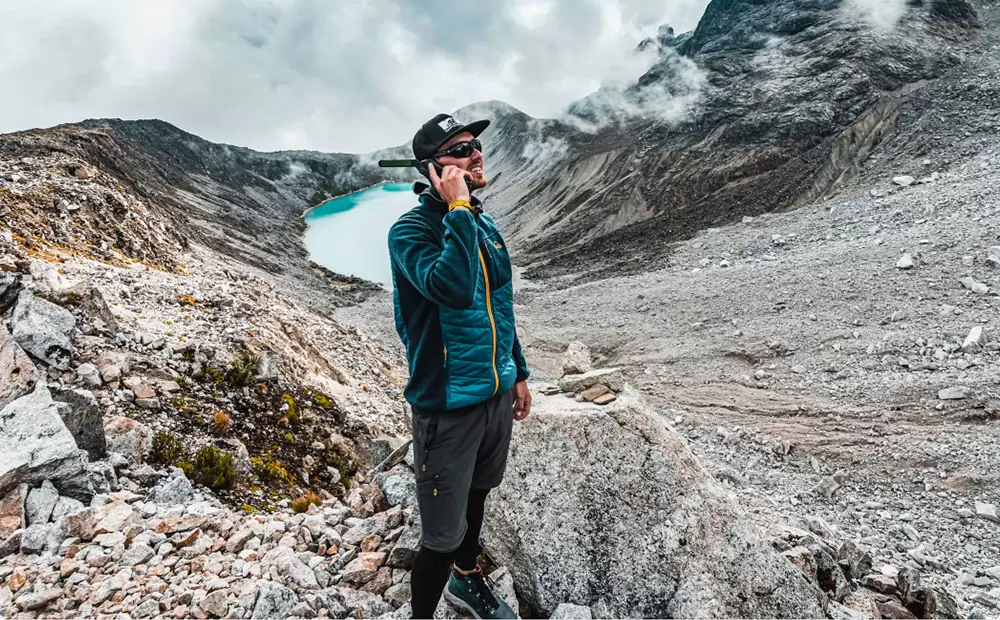
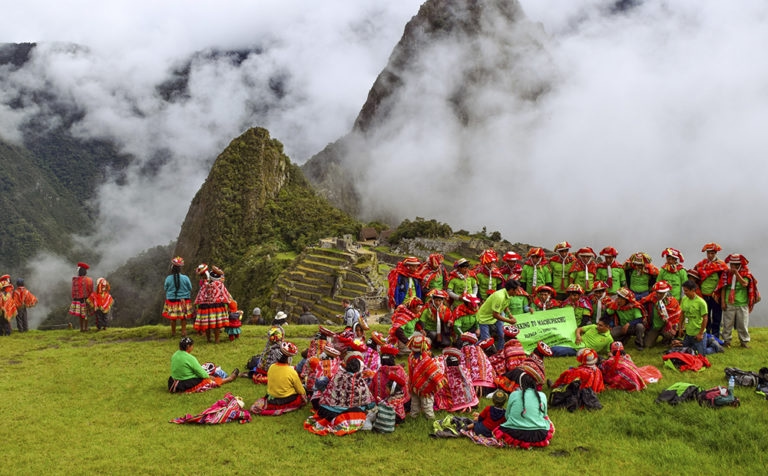
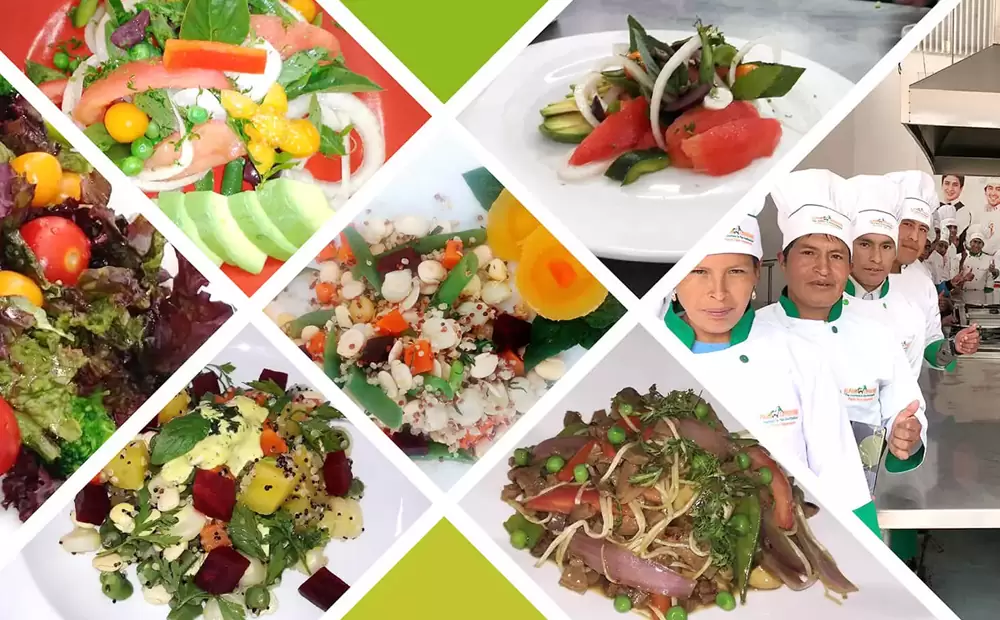



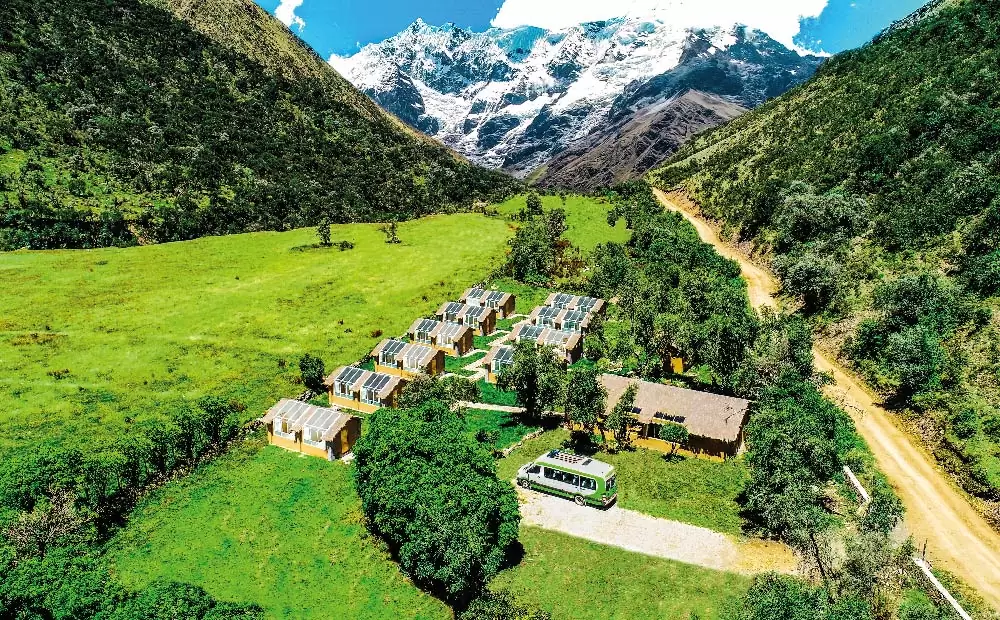
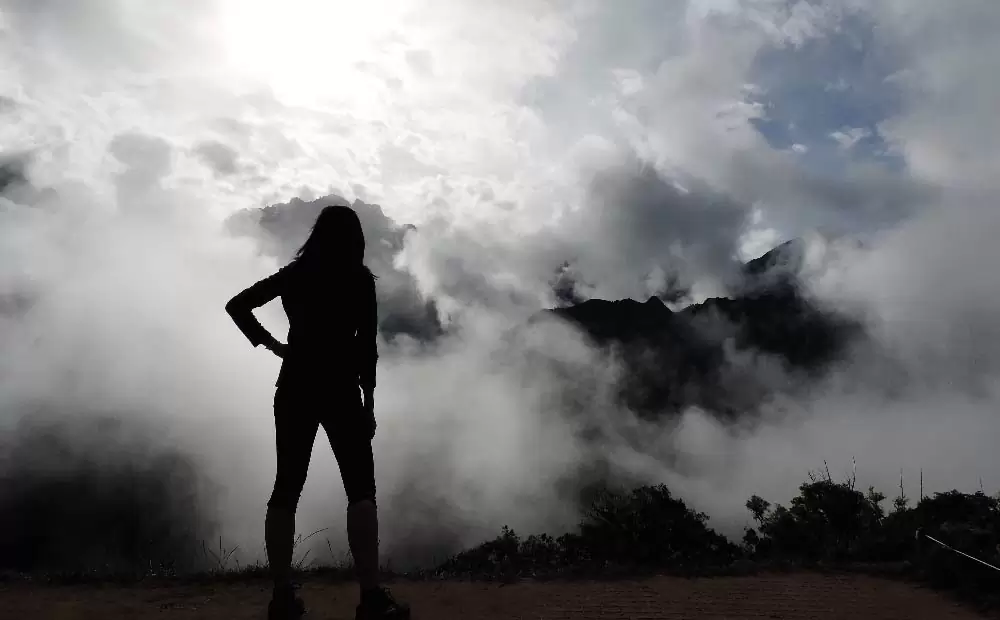



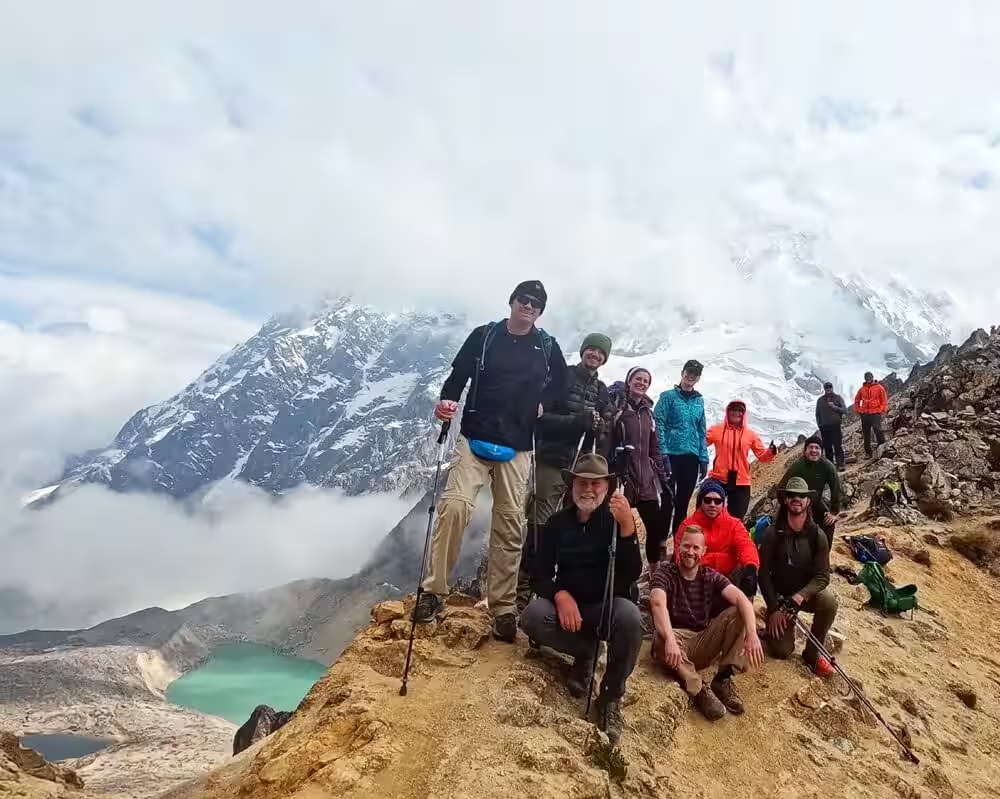
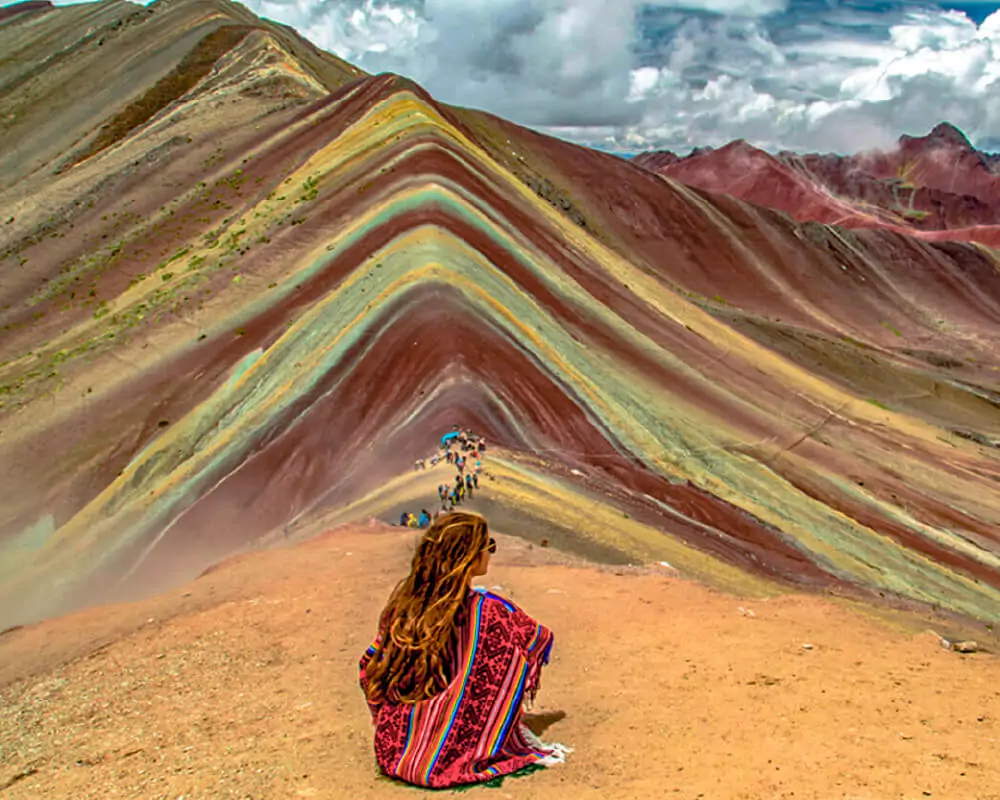
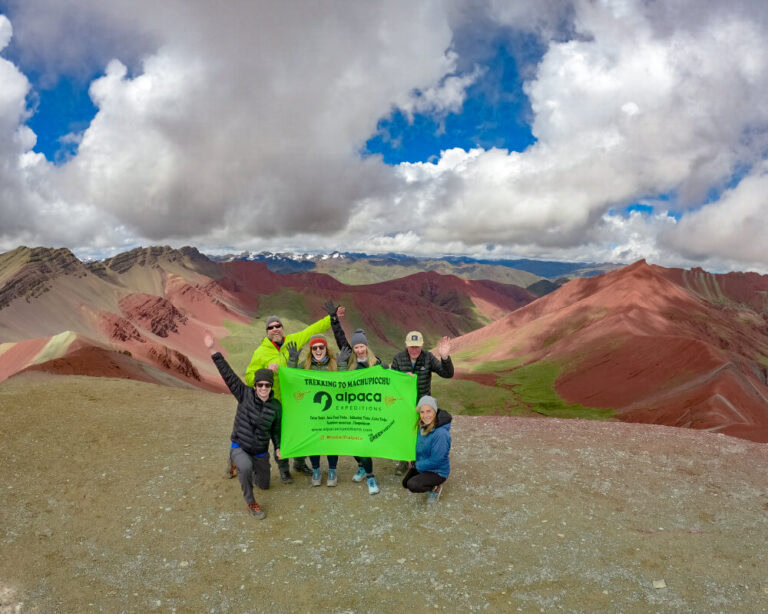
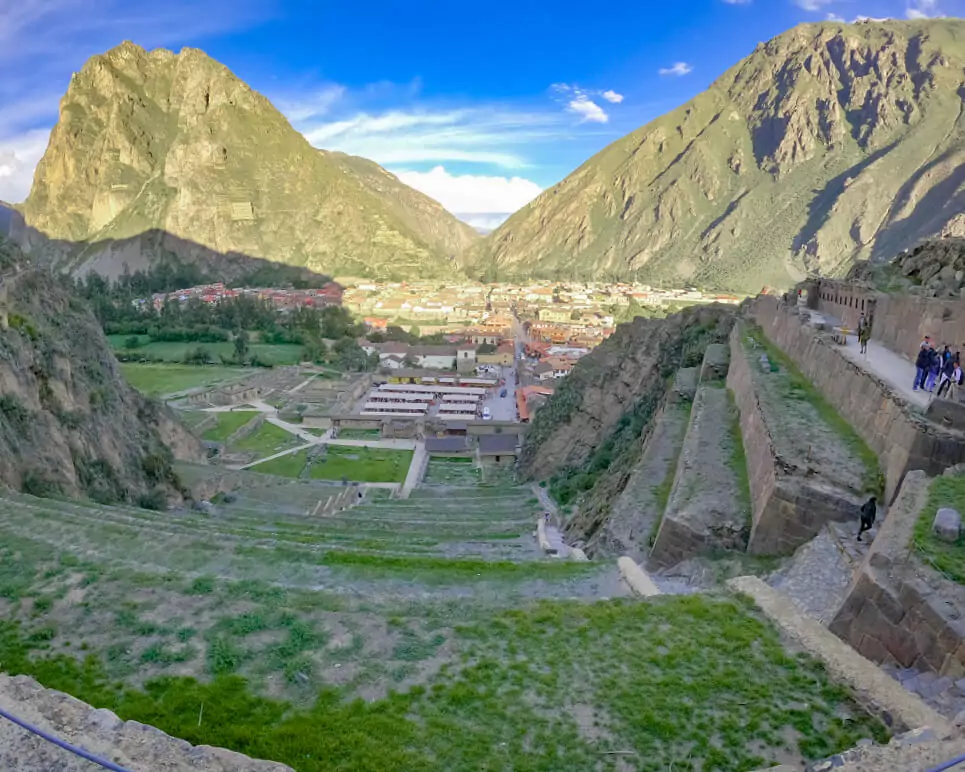
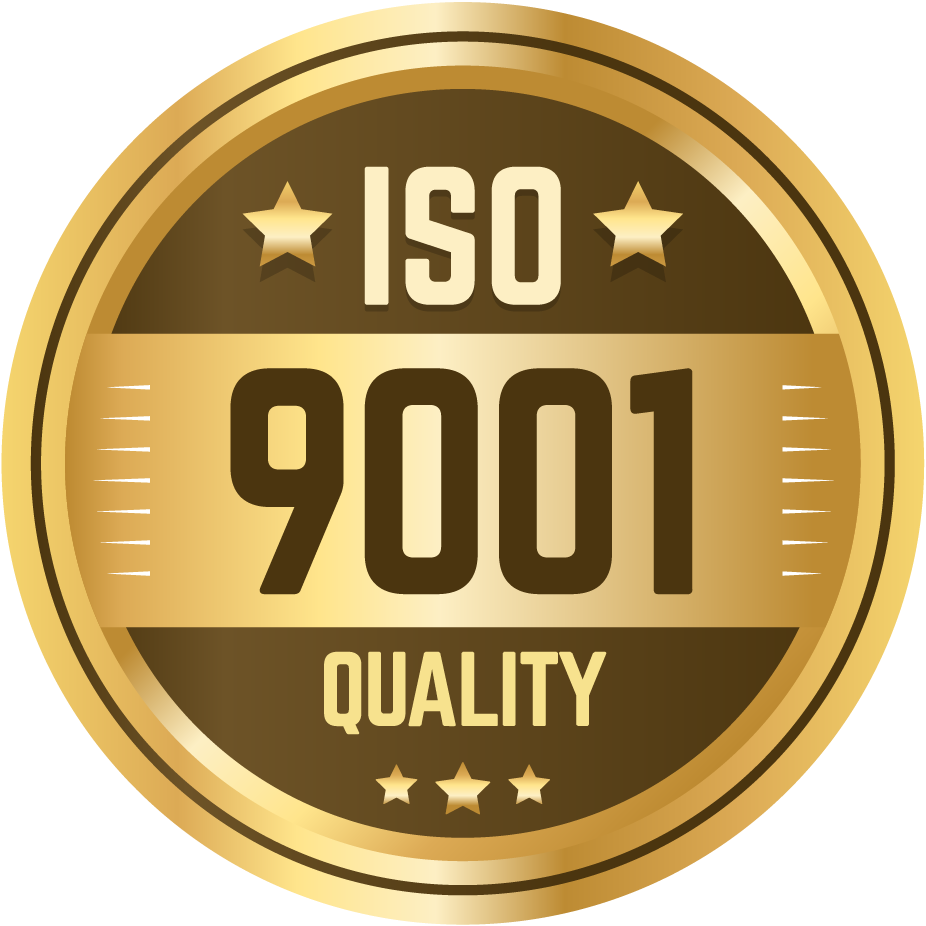
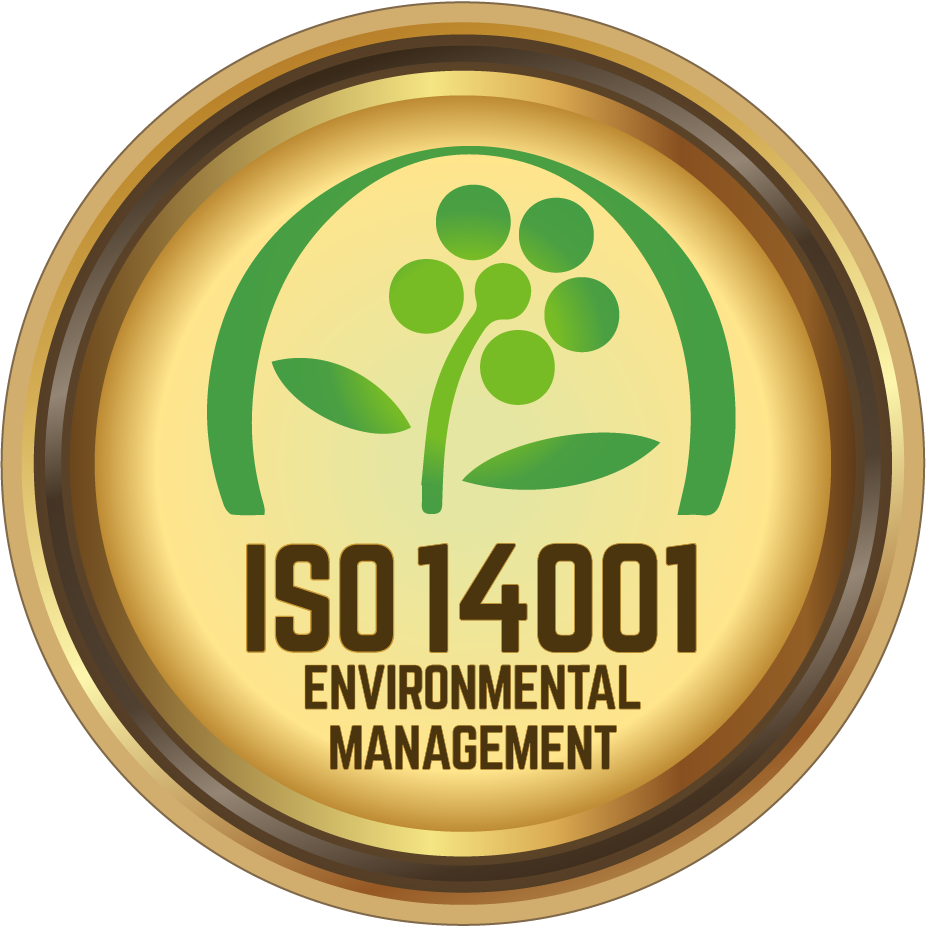



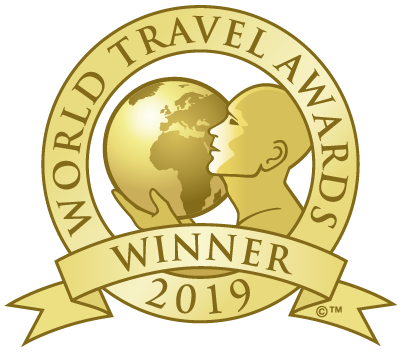











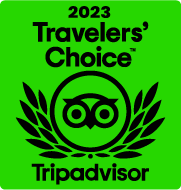













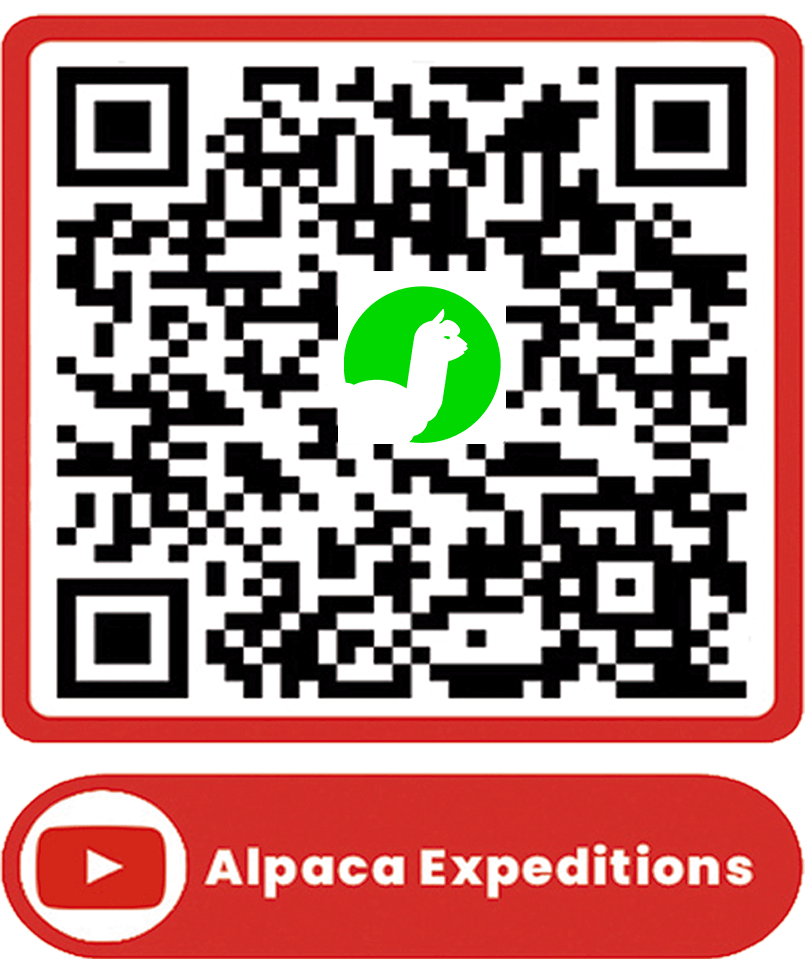

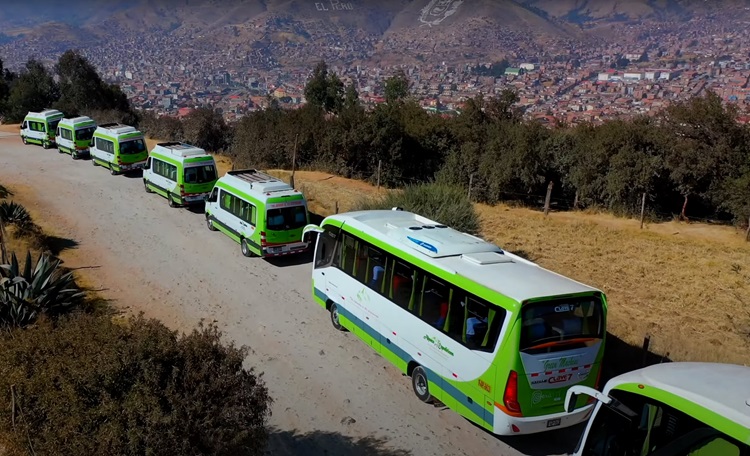
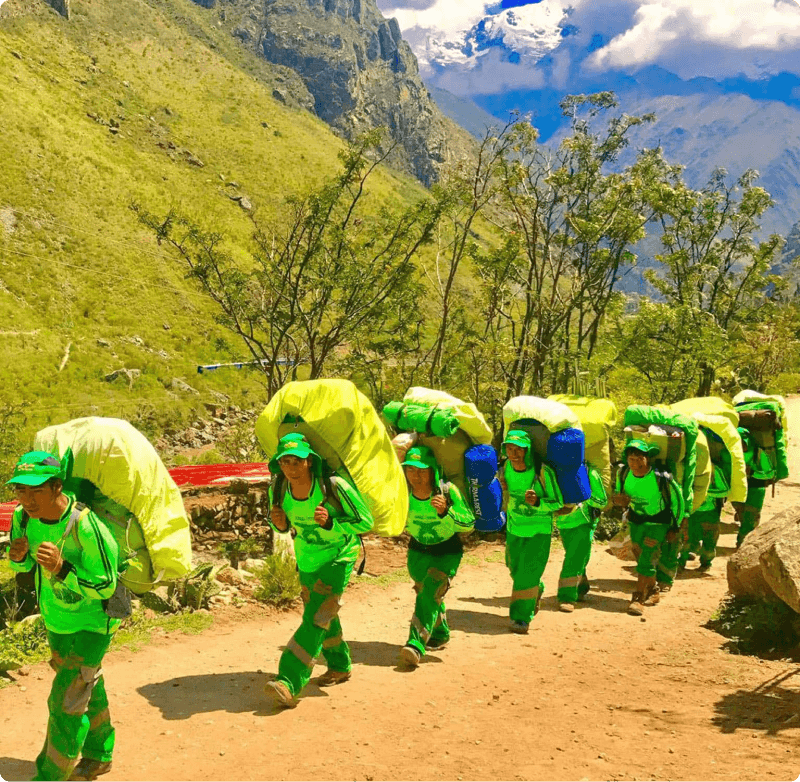 Porters will carry up to 7 kg of your personal items, which must include your sleeping bag and air mat (if you bring or rent one). From us, these two items weigh a combined total of 3.5 kg.
Porters will carry up to 7 kg of your personal items, which must include your sleeping bag and air mat (if you bring or rent one). From us, these two items weigh a combined total of 3.5 kg.